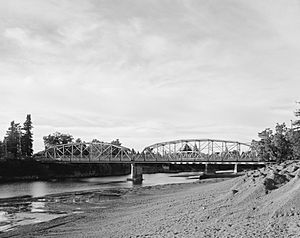Healdsburg Memorial Bridge facts for kids
Quick facts for kids Healdsburg Memorial Bridge |
|
|---|---|
 |
|
| Coordinates | 38°36′14″N 122°51′36″W / 38.604°N 122.860°W |
| Carries | auto, pedestrian and bicycle traffic |
| Crosses | Russian River |
| Locale | Healdsburg, California |
| Characteristics | |
| Total length | 438 feet (134 m) |
| Width | 19.4 feet (5.9 m) |
| Longest span | 198 feet (60 m) |
| Number of spans | 2 |
| Clearance above | 14.9 feet (4.5 m) |
| History | |
| Constructed by | American Bridge Company |
| Opened | 1921 |
| Statistics | |
| Daily traffic | 7400 vehicles/day |
The Healdsburg Memorial Bridge is a cool steel truss bridge that crosses the Russian River in Healdsburg, California. It's a very important landmark in the area. This bridge is so special that it's listed on the National Register of Historic Places. You can often see it from nearby U.S. Route 101.
Contents
About the Healdsburg Bridge
The Healdsburg Memorial Bridge is a special type of bridge called a Pennsylvania (Petit) truss bridge. This design used to be very popular. It was named after the Pennsylvania Railroad.
Today, this type of bridge is not built much anymore. The Healdsburg bridge is one of only two bridges like it in California that still carries cars. It is also one of only 13 in the entire United States. The bridge has two main sections, called truss spans. Each of these sections has ten panels.
Bridge Size and Use
The whole bridge is about 438 feet (133 meters) long. The longer of its two main sections is 198 feet (60 meters) long. The bridge deck, which is the part you drive on, is about 19.4 feet (5.9 meters) wide. It has a vertical clearance of 14.9 feet (4.5 meters).
Because its deck is a bit narrow, it doesn't quite meet today's newest safety rules. This means it's considered "functionally obsolete." This just means it's an older design, not that it's unsafe.
The bridge is quite busy, with about 7,400 vehicles crossing it every day. It carries traffic on Healdsburg Avenue, which is a local road. People can also walk or ride bikes across it. The east end of the bridge is right next to Healdsburg Veterans Memorial Beach Park. Another bridge, for a railroad, crosses the river nearby to the north. It also ends in the same park.
Bridge History: A Look Back
The spot where the bridge stands today was used by early settlers in Sonoma County. They used it as a shallow crossing point for the river way back in the 1850s. The Healdsburg Memorial Bridge was built in 1921. It was constructed by the American Bridge Company. When it was first built, it was the only steel bridge crossing the Russian River.
Back then, a temporary dam was built downriver each year. This created a popular swimming area. Even today, that part of the river is still a favorite spot for swimming.
Changes Over Time
Later, U.S. Route 101 was built. This new highway crossed the river in a different spot, further to the west. Because of this, most of the cars that used to cross the Memorial Bridge started using the new highway instead. The original bridge design even had decorative lights. These lights were taken off in the 1950s.
In 1979, a report about the bridge's structure came out. It suggested the bridge was in bad shape. Healdsburg city took control of the land around the bridge in 1980. In 1985, the bridge was recognized as important enough to be added to the National Register of Historic Places.
Even with this recognition, the city thought about replacing it in 1990. But the community didn't like that idea, so nothing happened. In 2000, the city made new plans for the bridge. These plans included making it stronger against earthquakes.
Modern Discoveries and Restoration
In 2007, something important was found: there were mistakes in that old 1979 report! A new report in 2008 showed that the bridge was actually still very strong and safe.
Because of this, the bridge was officially listed on the National Register of Historic Places in April 2011. Then, in December 2011, the state and federal governments approved money to help fix it up. This money depended on the city agreeing to pay for the bridge's ongoing care.
The work to make the bridge stronger and restore it was finished in 2015. This project involved building a new support in the middle of the river. They also added special parts to help it move safely during an earthquake. Plus, they made the main steel parts stronger and replaced the entire deck where cars drive.
Historic American Engineering Record (HAER) No. CA-269, "Redwood National & State Parks Roads", 66 photos, 51 color transparencies, 124 data pages, 9 photo caption pages
Images for kids



